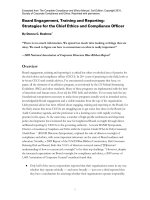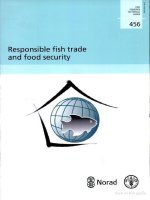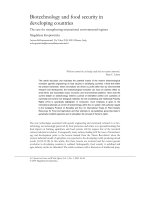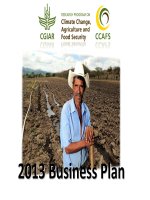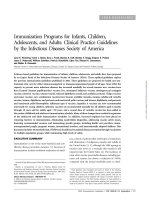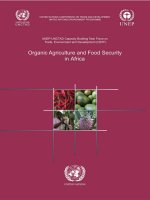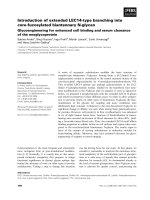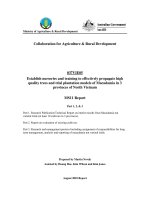Smart strategies for enhanced agricultural resilience and food security under a changing climate in irrigated agro-ecosystem of north west IGP: A review
Bạn đang xem bản rút gọn của tài liệu. Xem và tải ngay bản đầy đủ của tài liệu tại đây (413.88 KB, 13 trang )
Int.J.Curr.Microbiol.App.Sci (2019) 8(9): 951-963
International Journal of Current Microbiology and Applied Sciences
ISSN: 2319-7706 Volume 8 Number 09 (2019)
Journal homepage:
Review Article
/>
Smart Strategies for Enhanced Agricultural Resilience and Food Security
under a Changing Climate in Irrigated Agro-ecosystem of
North West IGP: A Review
S.P. Singh1, R.K.Naresh2, S.K. Gupta3, S.K. Tomar4, Amit Kumar5, Robin Kumar6,
N.C.Mahajan7, Yogesh Kumar8, Mayank Chaudhary9 and S.P. Singh10
1
KGK, Bareilly 2Department of Agronomy, 8Department of Soil Science, 9Department of GPB,
10
K.V.K.Shamli, Sardar Vallabhbhai Patel University of Agriculture & Technology,
Meerut, U.P., India
3
Department of Agronomy, Bihar Agricultural University - Sabour, Bhagalpur, Bihar, India
4
K.V.K.Belipur, Gorakhpu, NarendraDev University of Agriculture & Technology, Kumarganj,
Ayodhya, U.P., India
5
Department of Agronomy, CCS Haryana Agricultural University – Hisar, Haryana, India
6
Department of Soil Science, NarendraDev University of Agriculture & Technology, Kumarganj,
Ayodhya, U.P., India
7
Department of Agronomy, Institute of Agricultural Sciences, Banaras Hindu University,
Varanasi, U. P., India
*Corresponding author
ABSTRACT
Keywords
Adaptation
strategies, Climateresilience, Climate
change, Food
security
Article Info
Accepted:
15 August 2019
Available Online:
10 September 2019
Agriculture will face significant challenges in the 21 st century, largely due to the need to increase global food supply
under the declining availability of soil and water resources and increasing threats from climate change. Nonetheless,
these challenges also offer opportunities to develop and promote food and livelihood systems that have greater
environmental, economic and social resilience to risk. It is clear that success in meeting these challenges will require
both the application of current multidisciplinary knowledge, and the development of a range of technical and institutional
innovations.During last two decades, the atmospheric greenhouse gases (GHGs) concentrations have increased markedly.
Carbon dioxide (CO2), methane (CH4) and nitrous oxide (N2O) have increased from 280 ppm, 715 ppb and 270ppb
during pre-industrial era (1750 AD) to 385 ppm, 1797 ppb and 322 ppb, respectively in 2008. As on today, The CO2
concentration has exceeded 400 ppm. Increase in temperature can increase crop evapotranspiration and soil nutrient
mineralization and salinity, reduce crop duration, fertilizer use efficiency and may affect survival and distribution of
pests. Already scarce water resources will be further stressed under expected climatic changes. In the scenario of sealevel rise, the saline area under sea inundation will also extend and influence the crop production. Thus, changing climate
is likely to have a significant influence on agriculture and eventually the food security and livelihoods of a large rural
population. This paper identifies possible climate change responses that address agricultural production at the plant, and
farm, regional scales. Critical components required for the strategic assessment of adaptation capacity and anticipatory
adaptive planning is identified and examples of adaptive strategies for a number of key agricultural sectors are provided.
Adaptation must be fully consistent with agricultural rural development activities that safeguard food security and
increase the provision of sustainable ecosystem services, particularly where opportunities for additional financial flows
may exist, such as payments for carbon sequestration and ecosystem conservation. Climate change will affect agriculture
and forestry systems through higher temperatures, elevated CO2 concentration, precipitation changes, increased weeds,
pests, and disease pressure, and increased vulnerability of organic carbon pools. Benefits of adaptation vary with crop
species, temperature and rainfall changes. Useful synergies for adaptation and mitigation in agriculture, relevant to food
security exist and should be incorporated into development, and climate policy. Synergistic adaptation strategies to
enhance agro-ecosystem and livelihood resilience, including in the face of increased climatic pressures. Ensuring food
security without compromising sustainability of land resources under a rapidly growing population and changing climate
is among the major challenges of this era. Smart strategies individually offers a magic bullet solution to the foregoing
challenges and most of the promising technologies are founded on local knowledge, local and scientific knowledge must
be integrated when choosing the most suitable climate-smart technologies and practices for any given agro-ecology.
951
Int.J.Curr.Microbiol.App.Sci (2019) 8(9): 951-963
Introduction
End hunger, achieve food security and
improve nutrition is at the heart of the
sustainable development goals. At the same
time, climate change is already impacting
agriculture1 and food security and will make
the challenge of ending hunger and
malnutrition even more difficult. The effects
of climate change on our ecosystems are
already severe and widespread, and ensuring
food security in the face of climate change is
among the most daunting challenges facing
humankind. While some of the problems
associated with climate change are emerging
gradually, action is urgently needed now in
order to allow enough time to build resilience
into agricultural production systems.
Climate change pertains to increase in
atmospheric concentration of carbon dioxide
(CO2) and global warming. Present day
atmospheric CO2 level hovers around 397 ppm
which is a significant increase over the preindustrial level of 280 ppm. It is anticipated
that the concentration level will double by the
end of this century (IPCC, 2007).The good
news is that agriculture can be integrated into
the solution to reduce the pace of climate
change by sequestering carbon in the soil
instead of emitting it into the atmosphere. It is
possible to achieve what the World Bank
(2010) terms ―climate-smart agriculture‖ or
―triple wins‖: attaining higher yields, placing
more carbon in the soil, and achieving greater
resilience to heat and drought. A consequence
of increased greenhouse gas (GHG) emissions
is the entrapment of heat within the earth's
atmosphere leading to an alarming rate of
global warming. Global average increase in
mean annual temperatures is estimated at
0.8°C till now. An increasing rate of warming
has taken place across sampling areas spread
across the globe over the last 25 years. Global
mean temperatures are likely to witness
significant increase towards the end of this
century. Between seasons, warming in the
rainy season will be less pronounced than in
the winter months in India (IMD, 2010).
Another climate change feature significantly
influencing agro-ecosystems is the change in
seasonal
rainfall
patterns.
Increased
frequencies in occurrence of extreme weather
events such as heat wave, cold wave and hail
storm over short periods exert adverse
influence on crop performance. Rainfall is
predicted to be highly erratic with fewer rainy
days but with greater intensity. A combination
of higher average annual temperatures and
water stress can have serious implications for
crop production in the tropics. Farmers need to
intelligently adapt to the changing climate in
order to sustain crop yields and farm income.
Enhancing resilience of agriculture to climate
risk is of paramount importance for protecting
livelihoods of small and marginal farmers.
Traditionally,
technology
transfer
in
agriculture has aimed at enhancing farm
productivity. However, in the context of
climate change and variability, farmers need
to adapt quickly to enhance their resilience to
increasing threats of climatic variability such
as droughts, floods and other extreme climatic
events. Over the years, an array of practices
and technologies has been developed by
researchers towards fostering stability in
agricultural production against the onslaught
of seasonal variations. Adoption of such
resilient practices and technologies by farmers
appears to be more a necessity than an option.
Therefore, a reorientation in technology
transfer approach is necessary. Efficiency in
resource-use, environmental and social
safeguards, sustainability and long-term
development of agriculture assume greater
importance.
Crop yield studies focusing on India have
found that global warming has reduced wheat
yield by 5.2% from 1981 to 2009, despite
adaptation (Gupta et al., 2017). It is projected
that climate change would reduce rain-fed
952
Int.J.Curr.Microbiol.App.Sci (2019) 8(9): 951-963
maize yield by an average of 3.3–6.4% in
2030 and 5.2–12.2% in 2050 and irrigated
yield by 3–8% in 2030 and 5–14% in 2050 if
current varieties were grown (Tesfaye et al.,
2017). Despite variability in input use and
crop management, there is a negative effect of
both season-long and terminal heat stress on
rice and wheat, though wheat is considerably
more sensitive than rice (Arshad et al.,
2017).Besides its impact on crop yields and
production, climate change also affects the
natural resources, primarily land and water
that are fundamental to agricultural
production. Water availability is expected to
decline due to climate change, while
agricultural water consumption is predicted to
increase by 19% in 2050 (UN-Water 2013).
For instance, growing reliance of Indian
farmers on groundwater to cope with climateinduced drought has led to a rapid decline in
the groundwater table, and it may worsen
further due to increased climatic variability in
future (Fishman 2018).It is projected that food
price changes between 2000 and 2050 are 2.5
times higher for major food crops and 1.5
times for livestock products with climate
change (Nelson et al., 2009). Therefore, in the
absence of adaptation measures to climate
change, North West IGP could lose an
equivalent of 1.8% of its annual gross
domestic product (GDP) by 2050 and 8.8% by
2100 (Ahmed and Suphachalasai, 2014). The
average total economic losses are projected to
be 8.7%.Since agriculture provides livelihood
to over 70% of the people, employs almost
60% of the labor force, and contributes 22%
of the regional gross domestic product (GDP)
(Wang et al., 2017), these losses of GDP will
have major consequences in agriculturedependent communities in the region (Ahmed
and
Suphachalasai,
2014).
Therefore,
improved understanding of impacts of climate
change in agriculture and the adaptation
practices to cope with these impacts are
essential to enhance the sustainability of
agriculture and to design the policies that
reduce poor farmers’ vulnerability to climate
change in North West IGP.
Adaptation to climate change involves any
activity designed to reduce vulnerability and
enhance the resilience of the system (Vogel
and Meyer 2018), and therefore, the actual
impacts of climate change largely depend on
the adaptive capacity (Vermeulen et al.,
2012). Adaptation is particularly fundamental
to North West IGP agriculture for the
following reasons: (1) agriculture is a primary
source of livelihood; (2) fragmented and
small land size—less than a hectare—reducing
farmers’ capacity to adapt to climate change;
(3) increased population and high economic
growth has further exacerbated the adverse
impacts of climate change due to increased
demand for land and water from other sectors
of the economy mainly driven by search for
alternative farm practices; (4) less developed
risk and insurance market to promote
adaptation to climate change; and (5) to
sustain local food security, especially of the
poor and small farmers against the high food
price fluctuation under extreme climatic
variability. On this backdrop, this review
paper examines the prospects of the
smallholder production system in North West
IGP to adapt to climatic variability to
minimize the negative impacts of climate
change on food systems. We also discuss why
farmers use few adaptation measures, if any,
despite the prevalence of several measures in
light of the existing barriers and policy setup.
Moreover, documents the impact of climate
change on agriculture and multiple adaptation
measures applied in the agricultural sector in
North West IGP. The climate change
adaptation policies and future prospects of
agriculture in North West IGP with a due
focus on existing barriers.
―What is of the greatest importance in our
present condition – on the one hand, bring
home to the commercial community the
953
Int.J.Curr.Microbiol.App.Sci (2019) 8(9): 951-963
inestimable value of science as an essential
factor of industrial regeneration, and, on the
other hand, make the landed aristocracy
realize that science enables us to solve
difficult agricultural problems and thereby
revolutionize agricultural methods.‖Food
security exists when all people, at all times,
have physical and economic access to
sufficient, safe and nutritious food that meets
their dietary needs and food preferences for an
active and healthy life (World Food Summit,
1996). There are four dimensions of food
security: availability of food, accessibility
(economically and physically), utilization (the
way it is used and assimilated by the human
body) and stability of these three dimensions.
What is needed is not only enough food being
produced globally –enough food is produced
globally now but there are still almost 800
million hungry people – but that everybody
has access to it, in the right quantity and
quality, all the time and established direct
consequences to food security:
Loss of rural livelihoods and income
Loss of marine and coastal ecosystems,
and livelihoods
Loss of terrestrial and inland water
ecosystems, and livelihoods
Food insecurity and breakdown of food
system
The aim of this review paper is to provide an
overview of the effects of climate change on
food security and nutrition, intended as its four
dimensions, and to explore ways to reduce
negative impacts through adaptation and
resilience.
Church et al., (2013) revealed that as seawater
continues to warm and glaciers and ice sheets
are lost, global average sea level will rise
during the twenty-first century faster than the
past decades. In 2046–2065 (relative to 1986–
2005), global average sea-level rise is likely in
the range of 0.17 to 0.32 m and 0.22 to 0.38 m
for the lowest and highest GHG concentration
pathways,
respectively
[Fig.1].Ocean
acidification in the surface ocean will follow
the rise of atmospheric CO2 concentration. It
is also likely that salinity will increase in the
tropical and subtropical and a decrease in the
western tropical Pacific is predicted over the
next few decades.
Fig.1Schematic representation of the cascading effects of climate change impacts on food
security and nutrition
954
Int.J.Curr.Microbiol.App.Sci (2019) 8(9): 951-963
Kirtman et al., (2013) also found that the
projected change in global average
temperature will likely be from 0.3 °C to 0.7
°C for the period 2016–2035 relative to the
reference period 1986–2005.The increase in
temperature will be larger on the land than
over the ocean and larger than the mean. It
will be larger in the Arctic (IPCC, 2014a).
There will be more frequent hot-temperature
extreme episodes over most land areas (IPCC,
2014b). Average precipitation will very likely
increase in high- and parts of the midlatitudes, and the frequency and intensity of
heavy precipitation will also likely increase
on average. The contrast in precipitation
between wet and dry regions and between wet
and dry seasons will increase. Short-duration
precipitation events will shift to more intense
individual storms and fewer weak storms are
likely as temperature rises. Shetty et al.,
(2013) reported that climate change is
projected to reduce timely sown irrigated
wheat production by about 6% by 2020. In the
case of late sown wheat, the projected levels
are alarmingly high, to the extent of 18%.
Similarly, a 4% fall in the yield of irrigated
rice crop and a 6% fall in rain-fed rice are
foreseen by 2020 due to climate changes. The
warming trend in India over the past 100
years is estimated at 0.60°C. The projected
impacts are likely to further aggravate yield
fluctuations of may crops with impact on food
security. It requires a serious attention on
adaptation and mitigation strategies to
overcome the problems of climate change.
wheat, between –5 and –20 per-cent for rice,
and between 0 and –30 per-cents for soybean.
If nitrogen limitations are explicitly
considered, crops show less profit from CO2
fertilization and amplified negative climate
impacts. Uleberg et al., (2014) noted that,
despite challenges such as unstable winters,
increased autumn precipitation and possibly
more weeds and diseases, a prolongation of
the current short growth season together with
higher growth temperatures can give new
opportunities for agriculture in the region, but
that it will require tailored adaptive strategies,
breeding of new plant varieties, changes in
sowing calendar and crop rotation, etc. –
adaptive changes that seem feasible given the
agronomical knowledge base in the region.
Adaptive changes in crop management –
especially planting dates, cultivar choice and
sometimes increased irrigation – have been
studied to varying extents, and in many
regions farmers are already adapting to
changing conditions, many of them being
changes made to existing climate risk
management practices. Müller and Elliott
(2015) found that adaptive changes in crop
management have the potential to increase
yields by about 7–15 per-cent on average,
though these results depend strongly on the
region and crop being considered: for
instance, according to IPCC (2007), responses
are dissimilar between wheat, maize and rice,
with temperate wheat and tropical rice
showing greater potential benefits of
adaptation.
Müller and Elliott, (2015) reported that by
2100 the impact of climate change on crop
yields for high-emission climate scenarios
ranges between –20 and –45 percent for
maize, between –5 and –50 per-cent for
wheat, between –20 and –30 per-cent for rice,
and between –30 and –60 per-cent for
soybean. Assuming full effectiveness of CO2
fertilization, climate change impacts would
then range between –10 and –35 per-cent for
maize, between +5 and –15 per-cent for
As agro-climatic zones may shift pole-ward,
cropping might be feasible in previously
unsuitable places, such as in parts of the
Russian Federation, Canada or of the
Scandinavian region, albeit with other
constraints due to climate extremes, water
limitations or other barriers. This might only
compensate for some of the losses in tropical
latitude areas. Developing cultivars with
appropriate thermal tolerance characteristics,
or resistant to drought, can be a solution
955
Int.J.Curr.Microbiol.App.Sci (2019) 8(9): 951-963
(Ziska et al., 2012). Increasing the efficiency
of scarce resources, particularly water, is an
important aspect of building resilient
livelihoods. One of the main effects of
climate change is altering rainfall and water
availability patterns, and thus a capacity to
deal with water scarcity will be important in
order to maintain productivity levels.
Adapting to increasing drought conditions and
water scarcity can be enabled by enhanced
water management in agriculture (HLPE
2015) with water storage and improved access
to irrigation water, improved irrigation
technologies and techniques. Agronomy
practices that enhance soil water retention
should also be considered, such as minimum
tillage, agro forestry or increase in soil carbon
and organic matter, among others. New tillage
practices can reduce the exposure of topsoil to
the air, reducing evaporation, improving soil
moisture characteristics and reducing
sensitivity to drought and heat. Breeding can
lead to new cultivars that send roots down
faster and deeper, increasing access to water
in the soil profile, or that are more robust to
underwater submergence conditions that
could become more common in a future
climate.
the heart of meeting this challenge (FAO,
2015c).
Agricultural adaptation
climate change impacts
strategies
to
Adapting to climate change entails taking the
right measures to reduce the negative effects
of climate change by making the appropriate
adjustments and changes. Adaptation has
three possible objectives: to reduce exposure
to the risk of damage; to develop the capacity
to cope with unavoidable damages; and to
take advantage of new opportunities.
Crop adaptation strategies
Planting of drought resistant varieties of
crops
Emphasis on more drought resistant crops in
drought-prone areas could help in reducing
vulnerability to climate change. For example,
wheat requires significantly less irrigation
water compared to dry season rice. The uses
of drought-resistant crop varieties have been
tried by smallholder farmers as adaptation
methods to climate change in Agro-ecosystem
of North West IGP (Ngigi, 2009).
An essential aspect of adaptation to climate
change will be that of increasing the diversity
within production systems. This can take
many forms: combining different types of
production in different ways; increasing the
numbers of different species, populations,
varieties or breeds; and increasing the use of
materials that are themselves genetically
diverse such as crop multiline. These different
approaches
will
help
provide
the
complementarity, option values and risk
minimizing strategies that will become
increasingly important in the future. Finding
ways to combine diversity-rich strategies with
the production demands of the future is one of
the major challenges for the future and the
improved maintenance and use of genetic
resources for food and agriculture will lie at
Change in cropping pattern and calendar
of planting
Climate change adversely affects crop
production through long-term alterations in
rainfall resulting in changes in cropping
pattern and calendar of operations.
Enabling
in-farm
diversification
and
off-farm
For most farming families, agriculture is only
one of several sources of income and smaller
size households often have higher shares of
non-agricultural incomes than larger ones. It
is also important to recognize that an
important strategy for increasing resilience
956
Int.J.Curr.Microbiol.App.Sci (2019) 8(9): 951-963
among agricultural based populations is to
diversify to non-agricultural sources of
income and in many cases to exit from
agriculture for employment opportunities in
other sectors. In many micro-level studies of
agricultural household welfare, the access to
off-farm income sources from labour
diversification
is
generally positively
associated with welfare levels. For example,
labour migration is a common strategy in the
face of climate risk and environmental
degradation, and remuneration from these
migrants plays an important role in
maintaining household resilience. Of course,
there is considerable variation in how well
these strategies actually do contribute to
livelihood resilience. In addition, evidence
indicates that the poor and most vulnerable to
climate risks are the least capable to
undertake effective migration, since they lack
the assets and social networks required. Nonagriculture-based livelihoods are likely to
play an increasingly important role in
building resilience among agricultural
populations due to projected population
growth patterns as well as potential climate
change impacts.
Mixed cropping
Mixed cropping involves growing two or
more crops in proximity in the same field.
The system is commonly practice where
cereals,
legumes
(beans)
and
nuts
(groundnuts) are grown together. The
advantages of mixing crops with varying
attributes are in terms of maturity period (e.g.
maize and beans), drought tolerance (maize
and sorghum), input requirements (cereals
and legumes) and end users of the product
(e.g. maize as food and sunflower for cash).
Improved irrigation efficiency
Success of climate change adaptation depends
on availability of fresh water in drought-prone
areas. It should be emphasized that most
adaptation methods provide benefits even
with the lower end of climate change
scenarios, such as improved irrigation
efficiency. As water becomes a limiting
factor, improved irrigation efficiency will
become an important adaptation tool,
especially in dry season, because irrigation
practices the for dry area are water intensive.
Climate change is expected to result in
decreased fresh water availability (surface and
groundwater) and reduced soil moisture
during the dry season, while the crop water
demand is expected to increase because of
increased evapo-transpiration caused by
climate change and the continuous
introduction of high-yielding varieties and
intensive agriculture (Selvaraju et al.,
2006).As temperature increases, farmers tend
to irrigate more frequently. Irrigation is
clearly an adaptation strategy to warming.
When precipitation increases, they tend to
irrigate less often and resort to natural rainfall
more often.
Thus it is important agriculture and nonagriculture sectors to access resilient
livelihoods. Diversification, both on-farms
with increased number of varieties, species
and breeds, including through mixed systems
such as crop/livestock, crop/fish or processing
products, and off-farm, by getting a nonagricultural job, is an important element of
climate change adaptation (Thornton and
Herrero, 2014). It is, however, very contextdependent, operates at farm level and requires
overcoming constraints of access to
information and initial cost of investment.
Household income diversification is not
restricted
to
developing
economies
(Kurukulasuriya and Rosenthal, 2013).
957
Int.J.Curr.Microbiol.App.Sci (2019) 8(9): 951-963
Adopting soil conservation measures that
conserve soil moisture
Other adaptation strategies
Labour migration
Soil conservation techniques are increasingly
practiced in North West IGP. Nyong et al.,
(2007) noted that local farmers in Western
U.P., India, conserve carbon in soils through
the use of zero tilling practices in cultivation,
mulching and other soil management
techniques. Natural mulches moderate soil
temperatures and extremes, suppress diseases
and harmful pests, and conserve soil moisture.
Before the advent of chemical fertilizers, local
farmers largely depended on organic farming,
which also is capable of reducing GHG
emissions.
Planting of
agroforestry
trees
(afforestation)
Migration is a dominant mode of labour
(seasonal migration), providing a critical
livelihood source. The role of remittances
derived from migration provides a key coping
mechanism in drought and non-drought years
but is one that can be dramatically affected by
periods of climate shock, when adjustments to
basic goods, such as food prices are impacted
by food aid and other interventions (Devereux
and Maxwell, 2001). Migration is an
important mechanism to deal with climate
stress. Temporary migration as an adaptive
response to climate stress is already apparent
in many areas. But the picture is nuanced; the
ability to migrate is a function of mobility and
resources (both financial and social). In other
words, the people most vulnerable to climate
change are not necessarily the ones most
likely to migrate.
and
Tree planting is the process of transplanting
tree seedlings, generally for forestry, land
reclamation, or landscaping purposes. It
differs from the transplantation of larger trees
in arboriculture, and from the lower cost but
slower and less reliable distribution of tree
seeds. In silviculture the activity is known as
reforestation, or afforestation, depending on
whether the area being planted has or has not
recently been forested.
Vulnerability assessment and tools
Impacts on agricultural productivity and other
aspects of the sector can lead to different
repercussions in household income and food
security. Vulnerability of livelihoods depends
on the capacity of local communities to
substitute a negatively affected production
system with an alternative that could prevent
losses in agricultural income, provide
subsistence production, or supply food to
urban markets. Vulnerability assessments
characterize and identify areas, households or
subpopulations that have particularly low
livelihood resilience. This helps adaptation
planners prioritize their actions and target
vulnerable
communities.
Vulnerability
assessments also provide the basis for the
development of strategies to increase the
resilience of systems and livelihoods to
climate change. The bottom-up approach, on
the other hand, focuses more on collecting
It involves planting seedlings over an area of
land where the forest has been harvested or
damaged by fire or disease or insects. Agro
forestry is a rational land-use planning system
that tries to find some balance in the raising of
food crops and forests (Adesina et al.,
1999).In addition to the fact that agroforestry
techniques can be perfected to cope with the
new conditions that are anticipated under a
drier condition and a higher population
density, they lead to an increase in the amount
of organic matter in the soil thereby
improving agricultural productivity and
reducing the pressure exerted on forests.
958
Int.J.Curr.Microbiol.App.Sci (2019) 8(9): 951-963
different indicators that would characterize
the vulnerability of agriculture sectors to
various risks, including climate change. There
are a wide variety of possible indicators,
including
socio-economic
resources,
technology, infrastructure, information and
skills, institutions, biophysical conditions and
equity (Brugère and De Young, 2015).
Climate change is one among many risks and
drivers of change for food insecurity and may
be an amplifier of existing vulnerabilities.
Vulnerability to climate change should be
seen in the context of existing broader socioeconomic and environmental conditions.
Contextual conditions of the society and
environment clarify their adaptive capacity
and vulnerability to potential threats.
Constraints in production
The various constraints or limitations are
responsible for poor performance in yield in
some of the states. Among the states where
there the highest yield levels had been
achieved, a yield plateau could possibly be
foreseen. Both the situations however need to
be addressed as the former situation is an
opportunity whereas the latter situation is a
threat. Thus the limitations to harness the
yield potential are many. One can delineate
such constraints as resource, technology and
policy based. The resource based including
land and irrigation limits the scale of
operation in the country. As the area sown
more than once has increased from 34.63
million hectares (1980-81) to 53.74 million
hectares, it resulted in an increase of cropping
intensity from 123 per cent to 138 per cent.
With reference to irrigation coverage, the
country’s net irrigated area has increased
from 38.72 million hectares to 63.20 million
hectares during the above period. However,
the percentage of irrigation coverage to the
net area sown has increased from 28 per cent
to 44.71 per cent. About 55 per cent of the
gross cropped area is still not covered under
irrigation inducing severe pressure on land.
Besides, differences do occur in irrigation
coverage among the various crops. The
declining average size of holding is another
major threat and limits the scale of operation.
The average size of operational holding in
India has come down steadily from 2.28
hectare in 1970-71 to 1.16 hectare in 2010-11.
Such marginal size of holding with marginal
rise in operational area would add more
number of marginal and small farmers
implying that there are nearly twice as many
farms as four decades ago. Developments in
molecular biology, bio technology, nano
technology etc. are expected to provide
significant new opportunities for yield
enhancement of various crops. These
technical developments also pose new
Integrate climate change concerns in all
agricultural and food security strategies
and policies
Numerous instruments and policies need to be
mobilized for adaptation, to build resilience of
agriculture and food systems to climate
change. This requires the elaboration of an
integrated strategy covering, first of all,
agriculture and food security policies and
measures, as well as those related to water
management, land and natural resource
management, rural development and social
protection, among others. Such an approach
can be part of broad, economy-wide
adaptation strategies and plans at national or
subnational levels. It calls for holistic
approaches
considering
agricultural
development for food security and nutrition in
the context of climate change, combining
practices, enabling policies and institutions as
well as financial resources. It is with such
objectives that FAO proposed in 2010 the
concept of climate-smart agriculture an
approach than can help decision-makers in the
agriculture sectors, from farm to national
authorities, integrate food security and
climate change concerns in their actions and
policies.
959
Int.J.Curr.Microbiol.App.Sci (2019) 8(9): 951-963
challenges like increased adaptation, capacity
building, and policy changes, regional and
global cooperation.
Intensification (SRI) is a synergistic
management technique involving four
components of rice farming such as planting,
irrigation, weed and nutrient management
strategies. Besides, few more packages
namely preparation of mat nursery,
transplanting and weeding are also
introduced. Modified mat nursery technique,
mechanized planter and weeder are also
developed. Mechanization of rice crop
production in irrigated eco-system, integration
of herbicidal and mechanical weed
management for different rice ecosystems and
rice production technologies for protected
agriculture
(precision
agriculture,
conservation agriculture) are the future
strategies for improvement of productivity of
rice in the country. Improving the efficiency
of water use through the use of sprinkler and
drip technology for improving the yield and
quality of maize, water logging during the
rainy season is the major problem for which
adequate drainage facilities should be
arranged since the crop is highly sensitive to
water logging. Moisture conservation
measures for rain-fed maize cultivation,
providing supplemental irrigation through
farm ponds and mobile sprinklers, skill
manpower for hybrid maize development and
seed production, technical and investment
support to private enterprises to establish
maize
seed
industry,
technological
interventions on low cost and efficient
management practices would lead to
substantial increase in maize production.
Innovations, technologies and strategies
Several categories of innovations have been
introduced to increase agricultural production
and productivity in the country. The
categories include mechanical innovations
(tractors and farm implements), biological
innovations (new varieties, hybrids, seeds
etc.,), chemical innovations (fertilizers and
pesticides), agronomic innovations (new
management practices), biotechnological
innovations and informational innovations
that rely mainly on computer technologies. In
crop improvement, biotechnology plays key
role in improving agronomic traits and quality
of food crops. Tools like genetic engineering,
marker assisted selection, genomics etc., help
us to improve many of the complex traits in
plants. One of the important applications of
genetic engineering is to improve plant traits
by over-expressing or suppressing specific
genes associated with the phenotypic trait.
Examples include improved yield, reduced
vulnerability of crops to environmental
stresses, enriching nutrient content in grains,
development of ―Golden rice‖ possessing
increased beta-carotene accumulation in rice
grains and rice grains possessing enriched
iron content by over-expressing ―Ferritin‖
gene(s). Few technologies are helping the
farmers to have reduced dependency on
fertilizers, pesticides and other agrochemicals.
For example, Bacillus thuringiensis (Bt) is a
soil bacterium that produces a protein with
insecticidal qualities (Bt toxin). Crop plants
have now been engineered to contain and
express the genes for Bt toxin, to impart
resistance against lepidopteran pests.
In conclusion, climate changes are alarming
the world by hampering agriculture and its
products. Industrialization and poisonous
gases cause global warming, which ultimately
disturbs the world’s environment. Climate
change has devastating effects on plant
growth and yield. Abiotic stresses are the
major type of stresses that plants suffer. To
understand the plant responses under different
abiotic conditions the most pressing current
Besides in the farmer’s field through
extension support many technologies have
been developed and practiced. System of Rice
960
Int.J.Curr.Microbiol.App.Sci (2019) 8(9): 951-963
need is to explore the genetic basis underlying
these
mechanisms.
Some
bottleneck
molecular and physiological challenges
present in plants need to be resolved for better
plant adaptation under abiotic conditions.
Temperature fluctuations and variations in
rainfall spells are very crucial indicators of
environmental stresses. Weather variations
collectively have positive and negative
outcomes but the negative effects are more
thought-provoking. It is very difficult to
overcome the imbalance in agriculture by
climate change. How to tackle this problem
and what strategies we should apply are still
ambiguous. Hence, researchers need to focus
on optimizing plant growth and development
in abiotic stresses. For crop resistance against
biotic and abiotic stresses, propagating novel
cultural methods, implementing various
cropping schemes and different conventional
and non-conventional approaches will be
adopted to save agriculture in the future.
interventions, from social protection to
agricultural practices and risk management.
The changes on the ground needed for
adaptation to climate change in agriculture
and food systems for food security and
nutrition will require to be enabled by
investments, policies and institutions in
various areas. The people who are projected
to suffer the earlier and the worst impacts
from climate change are the most vulnerable
populations, with livelihoods depending on
agriculture sectors in areas vulnerable to
climate change. Understanding the cascade of
risks, as well as the vulnerabilities to these
risks, is key to frame ways to adapt. Reducing
vulnerabilities is key to reducing the net
impacts on food security and nutrition and
also to reducing long-term effects.
References
Adesina F.O, W.O. Siyambola, F.O Oketola, D.A
Pelemo, L.O Ojo, A.O. Adegbugbe. 1999.
Potentials of agroforestry for climate
change mitigation in Nigeria: Some
preliminary
estimates.
Glob.
Ecol.
Biogeogr. 8:163–173.
Ahmad, M., Siftain, H., andIqbal, M. 2014.
Impact of climate change on wheat
productivity in Pakistan: A district level
analysis, MRPA 72859, Climate Change
Working Paper No 1, Pakistan Institute of
Development
Economics,
Islamabad,
Pakistan
Ahmed, M., and Suphachalasai, S. 2014.
Assessing the costs of climate change and
adaptation in South Asia. Metro Manila:
Asian Development Bank.
Arshad, M., Amjath-Babu, T., Krupnik, T. J.,
Aravindakshan, S., Abbas, A., Kächele, H.,
et al., 2017. Climate variability and yield
risk in South Asia’s rice–wheat systems:
Emerging evidence from Pakistan. Paddy
Water Environ, 15: 249–261.
Brugère, C., & De Young, C. 2015. Assessing
climate change vulnerability in fisheries
and aquaculture: available methodologies
and their relevance for the sector. FAO
Fisheries and Aquaculture Technical Paper
Besides
developing
technologies
for
promoting intensification, the country needs
to emphasize development of technologies
that will facilitate agricultural diversification
particularly towards production of fruits,
vegetables, flowers and other high value crops
that are expected to increase income growth
and generate effective demand for food. Thus
identification of need-based productive
programs is very critical which can be
explored
through
characterization
of
production environment which are so diverse.
We have to develop demand-driven and
location-specific programs to meet the
requirements of different regions to meet the
targeted growth in agriculture. Besides,
because of the high variability in agroclimatic conditions, research has to become
increasingly location-specific with greater
participation or interaction with farmers.
Increasing resilience of food security in the
face of climate change calls for multiple
961
Int.J.Curr.Microbiol.App.Sci (2019) 8(9): 951-963
No. 597. Rome, FAO.
Church, J.A., Clark, P.U., Cazenave, A., Gregory,
J.M., Jevrejeva, S., Levermann, A.,
Merrifield, M.A., Milne, G.A., Nerem,
R.S., Nunn, R.D., Payne, A.J., Pfeffer,
W.T., Stammer, D. &Unnikrishnan,
A.S.2013. Sea level change. In T.F.
Stocker, D. Qin, G.-K. Plattner, M. Tignor,
S.K. Allen, J. Boschung, A. Nauels, Y. Xia,
V. Bex& P.M. Midgley, eds. Climate
change 2013: the physical science basis.
Contribution of Working Group I to the
Fifth
Assessment
Report
of
the
Intergovernmental Panel on Climate
Change, Cambridge, UK, and New York,
USA, Cambridge University Press.
Devereux, S., and S. Maxwell. 2001. Food
Security in Sub-Saharan Africa. ITDG
Publishing, London
FAO.2010. Report of the FAO workshop on
climate change and fisheries in the African
Great Lakes. Bujumbura, 20–21 April 2010
FAO.2015c. The Second Report on the State of the
World’s Animal Genetic Resources for
Food and Agriculture. B.D. Scherf& D.
Pilling, eds. FAO Commission on Genetic
Resources for Food and Agriculture
Assessments. Rome
Fiore, A.M., Kimoto, M., Meehl, G.A., Prather,
M., Sarr, A., Schär, C., Sutton, R., van
Oldenborgh,
Fishman, R. 2018. Groundwater depletion limits
the scope for adaptation to increased
rainfall variability in India. Climatic
Change, 147, 195–209.
G.J., Vecchi, G. & Wang, H.J. 2013. Near-term
climate
change:
projections
and
predictability. In T.F. Stocker, D. Qin,G.-K.
Plattner,
M. Tignor, S.K.
Allen,
J.,Boschung, A. Nauels, Y. Xia, V. Bex and
P.M.Midgley, eds. Climate change 2013:
the physical science basis. Contribution of
Working Group I tothe Fifth Assessment
Report of the Intergovernmental Panel on
Climate Change, Cambridge, UK,and New
York, USA, Cambridge University Press.
Gupta, R., Somanathan, E., and Dey, S. 2017.
Global warming and local air pollution have
reduced wheat yields in India. Climatic
Change, 140: 593–604.
HLPE.2013. Investing in smallholder agriculture
for food security. A report by the High
Level Panel of Experts on Food Security
and Nutrition of the Committee on World
Food Security, Rome.
HLPE.2015. Water for food security and
nutrition. A report by the High Level Panel
of Experts on Food Security and Nutrition
of the Committee on World Food Security,
Rome.
IPCC.2007. Climate change 2007: synthesis
report. Contribution of Working Groups I,
II and III to the Fourth Assessment Report
of the Intergovernmental Panel on Climate
Change. Core Writing Team, R.K.
Pachauri& A. Reisinger, eds. Geneva,
Switzerland, IPCC. 104 p.
IPCC.2014a. Climate change 2014: synthesis
report. Contribution of Working Groups I,
II and III to the Fifth Assessment Report of
the Intergovernmental Panel on Climate
Change. Core Writing Team, R.K.
Pachauri& L.A. Meyer, eds. Geneva,
Switzerland, IPCC. 151 p.
IPCC.2014b. Climate change 2014: impacts,
adaptation, and vulnerability. Part A:
Global and sectoral aspects. Contribution
of Working Group II to the Fifth
Assessment
Report
of
the
Intergovernmental Panel on Climate
Change. C.B. Field, V.R. Barros, D.J.
Dokken, K.J. Mach, M.D. Mastrandrea,
T.E. Bilir, M. Chatterjee, K.L. Ebi, Y.O.
Estrada, R.C. Genova, B. Girma, E.S.
Kissel, A.N. Levy, S. MacCracken, P.R.
Mastrandrea& L.L. White, eds. Cambridge,
UK, and New York, USA, Cambridge
University Press. 1132 p.
Kirtman, B., Power, S.B., Adedoyin, J.A., Boer,
G.J., Bojariu, R., Camilloni, I., DoblasReyes, F.J., Kurukulasuriya, P. and
Rosenthal, S. 2013. Climate change and
agriculture: a
review of
impacts
andadaptations. Environment Department
Papers No. 91. Climate Change Series.
Washington, DC, World Bank
Müller, C. and Elliott, J. 2015. The Global
Gridded Crop Model inter-comparison:
approaches, insights and caveats for
modelling climate change impacts on
agriculture at the global scale. In A.
Elbehri, ed. Climate change and food
962
Int.J.Curr.Microbiol.App.Sci (2019) 8(9): 951-963
systems:
global
assessments
and
implications for food security and trade.
Rome, FAO.
Nelson, G. C., Rosegrant, M. W., Koo, J.,
Robertson, R., Sulser, T., Zhu, T., et al.,
2009. Climate change: Impact on
agriculture and costs of adaptation.
Washington, DC: International Food Policy
Research Institute.
Ngigi, S.N. 2009. Climate change adaptation
strategies: Water resources management
options for smallholder farming systems in
Sub-Saharan Africa. The MDG Centre for
East and Southern Africa, the Earth Institute
at Columbia University, New York. Pp.189
Nyong, A., F. Adesina and O. Elasha 2007. The
value of indigenous knowledge in climate
change mitigation and adaptation strategies
in the African Sahel. Mitig. Adapt. Strat.
Glob. Change. 12: 787 -797.
Selvaraju,R., A.R. Subbiah, S. Baas and I.
Juergens. 2006. Livelihood adaptation to
climate variability and change in droughtprone areas of Bangladesh. Case Study
Project under Institution for Rural
Development, Pp. 1-76.
Shetty, P.K., Ayyappan, S., and Swaminathan,
M.S. 2013.Climate Change and Sustainable
Food Security, National Institute of
Advanced Studies Indian Institute of
Science Campus Bangalore,ISBN: 978-8187663-76-8
Tesfaye, K., Zaidi, P., Gbegbelegbe, S., Boeber,
C., Getaneh, F., Seetharam, K., et al., 2017.
Climate change impacts and potential
benefits of heat-tolerant maize in South
Asia. Theoretical ApplClim, 130, 959–970.
Thornton, P.K. andHerrero, M. 2014. Climate
change adaptation in mixed crop–livestock
systems indeveloping countries. Global
Food Security, 3(2): 99–107.
UN-Water. 2013. Climate change (WWW
document).
Vermeulen, S. J., Aggarwal, P. K., Ainslie, A.,
Angelone, C., Campbell, B. M., Challinor,
A. J., et al., 2012. Options for support to
agriculture and food security under climate
change. Environ SciPolicy, 15: 136–144.
Vogel, E., and Meyer, R. 2018. Chapter 3 Climate change, climate extremes, and
global food production—Adaptation in the
agricultural sector. In Z. Zommers& K.
Alverson (Eds.), Resilience (pp. 31–49).
Elsevier.
Wang, S. W., Lee, W.-K., and Son, Y. 2017. An
assessment of climate change impacts and
adaptation in South Asian agriculture. Int J
Clim Change Strategies Manag, 9: 517–
534.
World Food Summit. 1996. Rome Declaration on
World Food Security. Rome, FAO.
Ziska, L.H., Bunce, J.A., Shimono, H., Gealy,
D.R., Baker, J.T., Newton, P.C.D.,
Reynolds, M.P.,Jagadish, K.S.V., Zhu, C.,
Howden, M. and Wilson, L.T. 2012. Food
security and climate change:on the potential
to adapt global crop production by active
selection
to
rising
atmospheric
carbondioxide. Proceedings of the Royal
Society B, 279: 4097–4105.
How to cite this article:
Singh, S.P., Naresh, R.K., S.K. Gupta, S.K. Tomar, Amit Kumar, Robin Kumar, N.C. Mahajan,
Yogesh Kumar, Mayank Chaudhary and Singh, S.P. 2019. Smart Strategies for Enhanced
Agricultural Resilience and Food Security under a Changing Climate in Irrigated AgroEcosystem of North West IGP: A Review. Int.J.Curr.Microbiol.App.Sci. 8(09): 951-963.
doi: />
963

